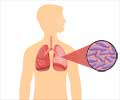Australia has one of the lowest incidence rates of TB in the world, and patients who have been treated for TB in Australia have a very low risk of having another disease episode.
The latest issue of the Medical Journal of Australia (MJA) features several articles on tuberculosis (TB) which look at the incidence of TB in Australia and the impact from rates of the disease in neighbouring countries.
Australia has one of the lowest incidence rates of TB in the world, and patients who have been treated for TB in Australia have a very low risk of having another disease episode.In their study of TB recurrence at a Sydney clinic, Dr Claudia Dobler and her colleagues from the Department of Respiratory Medicine at Liverpool Hospital in Sydney, found there were only three cases of disease recurrence over 13 years.
Dr Dobler says two of these cases were due to reinfection with a different strain but the low rates made it difficult to definitively predict whether reactivation or reinfection is more likely to cause TB recurrence in the local population.
“Recurrent TB due to reinfection ... is likely to be a consequence of visits to countries with high incidences of TB. Therefore, in the assessment of patients presenting with TB... taking a travel history is essential,” Dr Dobler says.
In their editorial for the journal, Dr Ivan Bastian, head of the WHO Supranational TB Reference Laboratory at Adelaide's Institute of Medical and Veterinary Science, and Dr Vicki Krause, Director of the Centre for Disease Control in Darwin, say that unfortunately in the 21st century TB still presents an urgent crisis for much of the world and that the people most affected by TB are the disadvantaged.
Those at risk include migrants, refugees, Indigenous Australians, and immunocompromised people including those with HIV.
Advertisement
Within our shores, the authors suggest various measures including optimising services for screening for and preventing TB in the above risk groups, increasing migrant awareness of available treatment services, and training health care workers to consider TB in at-risk patients.
Advertisement
TB in illegal foreign fishermen
In a study of TB rates among illegal foreign fishermen detained in Australia, Dr Natalie Gray and her colleagues from the Centre for Disease Control in Darwin found that health assessment processes successfully detected cases of TB, but that the fishermen were deported before treatment could be completed.
“Deporting fishermen before curative treatment is completed undermines TB control efforts and may lead to an emergence of drug resistance and an increased burden of active TB disease in our region,” says Dr Gray.
Dr Gray says that there are several barriers to the fishermen continuing treatment outside of Australia including lack of accessible TB clinics, high cost of medication, the stigma associated with the disease and personal debt.
“The logistical and financial burden of allowing fishermen to complete curative treatment in Australia is well within our capacity.”
Multidrug-resistant strains of TB (MDR-TB) are active in the Western Province of Papua New Guinea, and are now spreading to the Torres Strait Islands and Australia, according to a new study.
Dr Chris Coulter, Director at the Mycobacterium Reference Laboratory at Pathology Queensland, and his co-authors say urgent intervention is needed to stop further spread of the disease from PNG to the Torres Strait Islands.
“MDR-TB poses a serious threat to infected individuals and to whole communities,” Dr Coulter says.
The authors say there are a number of barriers to treatment in the PNG region, including transport costs, inadequate supply of medication, and access to clinics.
“With the close proximity of PNG to Australian territory, efforts to upscale control of TB in the Torres Strait are essential to ensure that MDR-TB does not become a problem in Queensland.
“Actions already taken include provision of travel vouchers, stockpiling of drugs in Cairns and on Thursday Island to ensure continuity of supply, and increased communication with health centres in PNG to improve management of TB patients.”
A retrospective review of children who were diagnosed with TB or tested for TB with tuberculin skin tests at The Children’s Hospital at Westmead between 2004-2006 suggests that increased testing of refugee children has increased the number of latent TB cases detected.
Dr Paul Robinson, Respiratory Fellow from the Department of Respiratory Medicine at The Children’s Hospital at Westmead, and his co-authors say the period of review included the establishment of a refugee clinic in 2005, which routinely tests refugees by tuberculin skin testing.
They reported higher rates of children with latent TB but not active TB.
“Children very rarely transmit active TB, but it is important to identify and treat latent TB to prevent progression to active disease later in life” Dr Robinson says.
“We believe our results indicate the need to screen refugees for latent TB.”
Source-MJA
SRM/M









